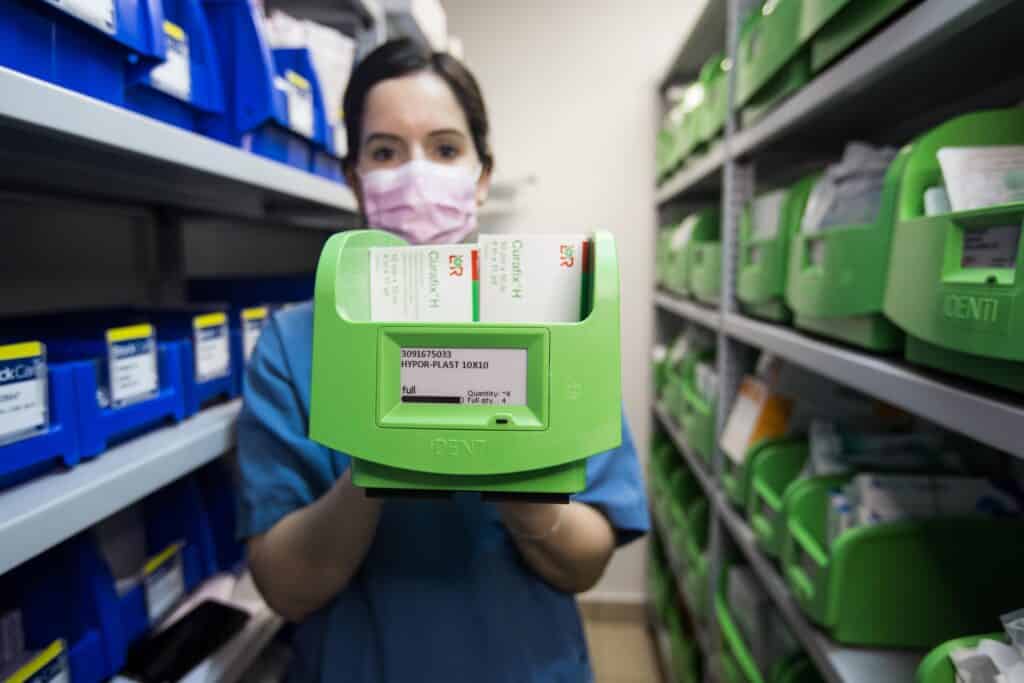What’s inside:
Discover what to look for in a weight-based inventory system to optimize hospital supply chains, reduce costs, and improve efficiency.
A weight-based inventory system is undoubtedly one of the most advanced and reliable solutions for automating PAR-level management today. But with multiple options available, how do you choose the right one?
Effective hospital inventory management is crucial for ensuring uninterrupted patient care. A robust weight-based system should provide real-time tracking, automated replenishment, and predictive analytics to optimize hospital supply chains.
Let’s break down the essential features that enhance efficiency, reduce costs, and free up clinical staff from inventory-related tasks.
1. Automated Replenishment – No More Stockouts or Overstocking
A high-quality weight-based inventory system should automatically detect when stock levels fall below a predefined threshold and trigger an order for replenishment before supplies run out.
Why It Matters:
- Eliminates the need for manual stock counting
- Ensures critical supplies are always available without overstocking
- Reduces administrative workload for nurses and supply chain managers
- Prevents last-minute orders and emergency deliveries, which often come at a premium cost
With automated replenishment, hospitals can avoid inventory shortages, prevent expired stock, and ensure supplies are replenished only when necessary, improving overall operational efficiency.
2. Real-Time Inventory Updates – Full Supply Visibility
A top-tier weight-based inventory system should provide real-time tracking of stock levels. As supplies are used, digital labels should update automatically and reflect the current stock status.
Why It Matters:
- No more outdated spreadsheets or paper records—everything is digital and instantly updated
- Eliminates printing and scanning errors that often lead to discounts
- Prevents unnecessary reorders by providing accurate stock levels at all times
- Enables hospital staff to see inventory levels remotely, reducing supply-related disruptions
With real-time visibility, hospitals can track supply movement down to individual SKUs, ensuring accurate usage data for improved forecasting and budgeting.

3. Predictive Analytics – Smarter Inventory Planning
AI-driven predictive analytics help hospitals optimize inventory levels by analyzing historical usage patterns and forecasting future demand.
Why It Matters:
- Prevents waste due to expired supplies
- Optimizes purchasing decisions based on real-time and historical data
- Ensures high-demand items are always in stock, preventing surgical delays
- Reduces costs by minimizing excess inventory
With AI-powered forecasting, hospitals can move from reactive inventory management to proactive planning, reducing costs while ensuring critical supplies are always available when needed.
4. Wireless Flexibility – Adaptable to Any Storage Space
Unlike traditional inventory systems that require fixed shelving or wired connections, a modern weight-based inventory system should be fully wireless, allowing bins to be placed anywhere in the facility.
Why It Matters:
- No cables, no wall-mounted units—systems can be deployed anywhere
- Bins can be placed on open shelving, carts, or storage racks, optimizing space utilization
- Allows for flexible expansion as supply needs change
- Easily integrates into existing hospital storage areas without requiring renovations
Wireless solutions eliminate installation constraints, making weight-based inventory systems ideal for hospitals, surgery centers, and emergency rooms where space and mobility are crucial.

5. Seamless Integration with ERP and MMIS Systems
A top-tier weight-based inventory system should integrate effortlessly with existing hospital ERP (Enterprise Resource Planning) and MMIS (Materials Management Information Systems) platforms.
Why It Matters:
- Provides a centralized dashboard for monitoring stock levels across multiple locations
- Eliminates duplicate data entry, reducing human errors and administrative workload
- Streamlines ordering, tracking, and billing processes
- Enhances decision-making with real-time data sharing between departments
Hospitals shouldn’t have to work in silos. Integration with ERP and MMIS systems ensures that inventory data is accurate, up-to-date, and accessible in one centralized platform.
6. More Time for Nurses – Less Time Managing Inventory
Nurses and clinical staff should never have to waste time on inventory management. A fully automated weight-based inventory system eliminates logistics tasks, allowing nurses to focus on patient care.
Why It Matters:
- Frees up clinical staff from supply chain duties
- Reduces nurse burnout by removing non-clinical responsibilities
- Eliminates time-consuming stock checks and manual reporting
- Improves patient care outcomes by allowing nurses to dedicate more time to patients
By removing nurses from inventory processes, hospitals can improve workplace efficiency and staff satisfaction, leading to better patient care and smoother operations.

The Future of Hospital Inventory Management
A weight-based inventory system is no longer a “nice-to-have”—it’s a must-have for hospitals looking to optimize supply chain operations. When selecting a system, make sure it includes:
- Automated replenishment to maintain optimal PAR levels
- Real-time inventory tracking for accurate supply data
- AI-powered predictive analytics for smarter forecasting
- Wireless design for adaptable storage solutions
- Seamless ERP/MMIS integration for centralized management
- Eliminating inventory tasks for nurses to improve patient care
With the right weight-based inventory system, hospitals can reduce costs, improve efficiency, and ensure supplies are always available when needed.
Want to learn how IDENTI’s weight-based inventory system can revolutionize your supply chain?






